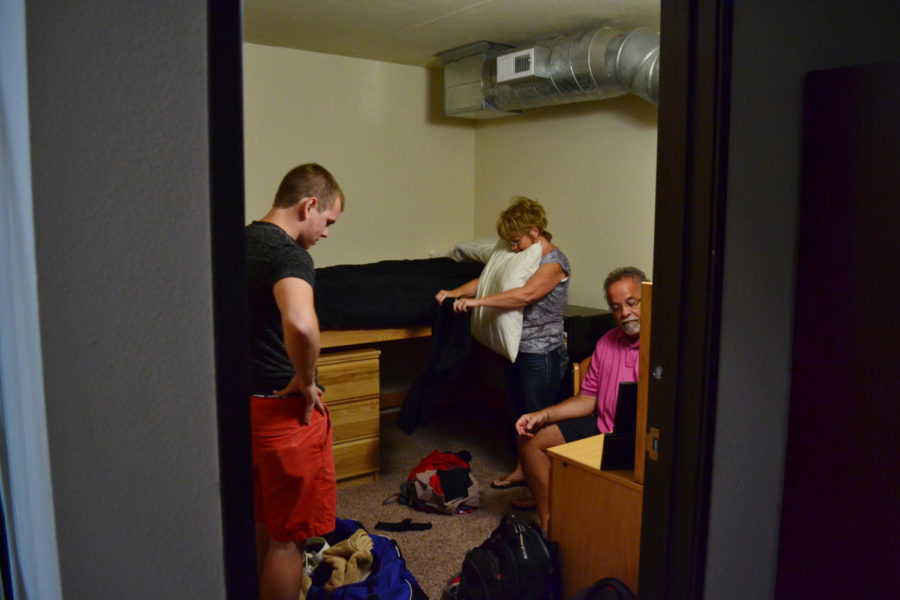Not yet settled: DOR leases off-campus space to meet demand
Brian Achenbach/Iowa State Daily
Sophomore Dustin Meyermann, left, moves into his room in Legacy Towers on Aug. 20. Meyermann is helped by Jim Savory and his mother Vicky Meyermann.
August 25, 2013
When the Department of Residence finished re-contracting with ISU students for the 2013-14 academic year, it realized a problem. The department would be approximately 1,200 bed-spaces short of meeting the high demand for campus housing.
Last year, 10,426 students lived on campus. DOR anticipates more than 11,200 residents this academic year. The return rate between the two years increased by 7.2 percent.
To make up for the lack of accommodations available, DOR was forced to come up with fast solutions to continue honoring its tradition of providing on-campus housing for all students who request it. These solutions include adding 720 beds at Frederiksen Court, of which only 240 will be available in August. Additionally, 424 students have been placed in residence hall dens and community spaces, with another 503 students placed in off-campus space leased by DOR.
That last course of action, one the university had never undertaken before, entailed the university leasing 299 bed spaces in Legacy Towers apartments on Stanton Avenue.
“I know a lot of [residents] like the fact that they have the apartment-style living that you would get in [Frederiksen Court] without living that far away from campus,” said Adam Kaas, senior in electrical engineering and one of 12 community advisers at Legacy.
Legacy residence is offered at the Frederiksen Court rates for private occupancy, which ranges from $5,257 per year for a four-bedroom apartment to $6,424 per year for a two-bedroom apartment.
This housing option offers a higher than average resident to CA ratio, approximately 1 to 25, in addition to other unique aspects.
The space previously known as the Legend’s restaurant has been remodeled into one of two major community spaces for students. In addition to remodeling that area, more than 3,000 new pieces of furniture were added throughout the building. Residents also have access to the Resort, which includes workout facilities, pool and hot tub.
Iowa State has signed a one-year lease for space in Legacy, including office space on the second floor and the entire fourth through seventh floors.
“There are a few private tenants that are in the building. … There’s three different kind of business ventures that are in there apart from us,” said Peter Englin, director of DOR.
The leasing contract Iowa State signed runs from Aug. 1 to July 31.
The building historically has been operated mainly as a student living environment, Englin said.
“It was not a situation where the department of residence asked anyone to leave. We were looking for leasing opportunities and the Campustown properties folks were able to work with us and [were] able to offer us the space, and then … they worked with those students to relocate them,” said Carolyn Duven, residence hall coordinator of Legacy, referring to students already living in the building.
The building is owned by American Campus Communities and is occupied mostly by returning students, Duven said.
“We did not assign any … direct-from-high-school, 18-year-old freshmen to Maricopa or Legacy,” Englin said.
Maricopa is where Iowa State leased the rest of its off-campus living spaces, Englin said. The units, which include 204 beds, are located in West Ames.
“There isn’t the kind of community space available there,” Englin said. “It really is just apartments.”
The DOR is looking into building a residence hall in order to accommodate the growing student population.
“Our goal is certainly to serve every student who wants to live on campus,” Englin said. “But if we were to do a residence hall kind of build, you’re minimally looking at a two-year process to do that. It’s a much more expensive process; it takes longer to build; it’s a long-term commitment in order to operate it. And so what you’re also trying to gauge is: How long will the demand for on-campus housing exist?”
Englin said, he expects a decision on whether or not to build additional residence hall space to be made within the next year.
“The planning that we’re currently looking at is: Should we add residence hall space, and if we did, what would it look like? And then, how do you best pay for it so it’s still of good value to students?” Englin said. “So that’s what we’re in the process of now is looking at potentially adding some residence hall spaces.”
The Inter-Residence Hall Association will be based on some of the student input the DOR receives on the matter.
“We want to get their thinking on some of this too,” Englin said. “Our desire is always to things with students, not to them.”

















